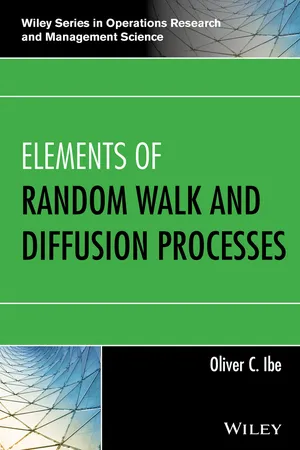
- English
- ePUB (mobile friendly)
- Available on iOS & Android
Elements of Random Walk and Diffusion Processes
About this book
Presents an important and unique introduction to random walk theory
Random walk is a stochastic process that has proven to be a useful model in understanding discrete-state discrete-time processes across a wide spectrum of scientific disciplines. Elements of Random Walk and Diffusion Processes provides an interdisciplinary approach by including numerous practical examples and exercises with real-world applications in operations research, economics, engineering, and physics.
Featuring an introduction to powerful and general techniques that are used in the application of physical and dynamic processes, the book presents the connections between diffusion equations and random motion. Standard methods and applications of Brownian motion are addressed in addition to Levy motion, which has become popular in random searches in a variety of fields. The book also covers fractional calculus and introduces percolation theory and its relationship to diffusion processes.
With a strong emphasis on the relationship between random walk theory and diffusion processes, Elements of Random Walk and Diffusion Processes features:
- Basic concepts in probability, an overview of stochastic and fractional processes, and elements of graph theory
- Numerous practical applications of random walk across various disciplines, including how to model stock prices and gambling, describe the statistical properties of genetic drift, and simplify the random movement of molecules in liquids and gases
- Examples of the real-world applicability of random walk such as node movement and node failure in wireless networking, the size of the Web in computer science, and polymers in physics
- Plentiful examples and exercises throughout that illustrate the solution of many practical problems
Elements of Random Walk and Diffusion Processes is an ideal reference for researchers and professionals involved in operations research, economics, engineering, mathematics, and physics. The book is also an excellent textbook for upper-undergraduate and graduate level courses in probability and stochastic processes, stochastic models, random motion and Brownian theory, random walk theory, and diffusion process techniques.
Frequently asked questions
- Essential is ideal for learners and professionals who enjoy exploring a wide range of subjects. Access the Essential Library with 800,000+ trusted titles and best-sellers across business, personal growth, and the humanities. Includes unlimited reading time and Standard Read Aloud voice.
- Complete: Perfect for advanced learners and researchers needing full, unrestricted access. Unlock 1.4M+ books across hundreds of subjects, including academic and specialized titles. The Complete Plan also includes advanced features like Premium Read Aloud and Research Assistant.
Please note we cannot support devices running on iOS 13 and Android 7 or earlier. Learn more about using the app.
Information
CHAPTER 1
REVIEW OF PROBABILITY THEORY
1.1 INTRODUCTION
1.2 RANDOM VARIABLES



- P[X ≤ x] is the probability that X takes a value less than or equal to x.
- P[X > x] is the probability that X takes a value greater than x; this is equal to 1 − P[X ≤ x].
- P[a < X < b] is the probability that X takes a value that strictly lies between a and b.
1.2.1 Distribution Functions
Table of contents
- COVER
- WILEY SERIES IN OPERATIONS RESEARCH AND MANAGEMENT SCIENCE
- TITLE PAGE
- COPYRIGHT PAGE
- PREFACE
- ACKNOWLEDGMENTS
- CHAPTER 1: REVIEW OF PROBABILITY THEORY
- CHAPTER 2: OVERVIEW OF STOCHASTIC PROCESSES
- CHAPTER 3: ONE-DIMENSIONAL RANDOM WALK
- CHAPTER 4: TWO-DIMENSIONAL RANDOM WALK
- CHAPTER 5: BROWNIAN MOTION
- CHAPTER 6: INTRODUCTION TO STOCHASTIC CALCULUS
- CHAPTER 7: DIFFUSION PROCESSES
- CHAPTER 8: LEVY WALK
- CHAPTER 9: FRACTIONAL CALCULUS AND ITS APPLICATIONS
- CHAPTER 10: PERCOLATION THEORY
- REFERENCES
- INDEX